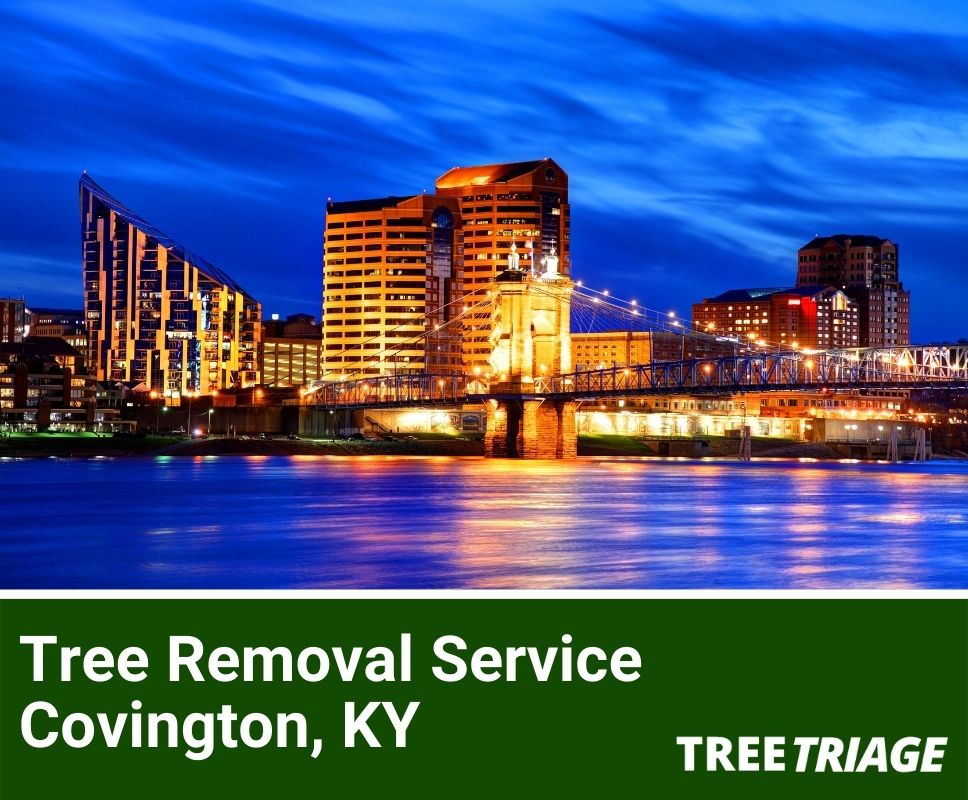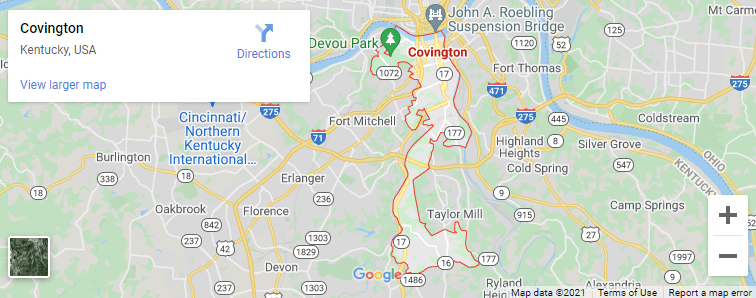Contents (Click To Jump)
- 1 What Are the Most Common Tree Issues in Covington?
- 2 Does the City of Covington Provide Any Assistance in Tree Removal Problems?
- 3 Who Is Responsible For Fallen Tree Removal in Covington?
- 4 How Does the Soil Affect Trees in Covington?
- 5 Does Weather Affect Tree Health in Covington?
- 6 What if Dead Trees Are Near Power Lines in Covington?
- 7 How Much Does Tree Removal Usually Cost in Covington?
What Are the Most Common Tree Issues in Covington?
Covington experiences the same tree diseases as the rest of Kentucky. This small city of about 40,000, located in Kenton County, rests across the river from Cincinnati, OH. Situated at the meeting point of the Licking River and the Ohio River, this town loves its trees and goes to great lengths to care for them. It makes the news when they have to cut trees down due to damage in their rights of way, and it also makes the news when the city plants them for Arbor Day. A few diseases attack these trees, mites love them, and the weather can wreak havoc on them.
Needle Cast Disease
The fungus Rhizosphaera sp. causes needle cast disease, which eventually causes the needles to drop off of the tree. At first, the disease symptoms may look very pretty since it causes the tree’s needles to turn various shades of purple and brown. The lower branches develop discoloration first, then the older needles. Progress continues up the tree until needles drop off of the tree. The stem tissue of the trees remains green, healthy, and supple, and the disease does not affect younger needles. If it goes untreated, repeated needle loss can cause twig dieback and tree decline leading to death.
Fungus Stigmina sp.
If you do not notice the color changes in the needles, look instead for small brown or black tufts sticking through the needles. They will somewhat resemble brush bristles, which signals that your spruce tree has become infected with the fungus Stigmina sp., which also causes spruce defoliation.
Fungus Rhizosphaera
Another fungus, Rhizosphaera, appears as fruiting bodies, also called pycnidia, on the needles. Look for your trees to have tiny, white-capped, gray raised bumps. These will stick through the needles’ pores, also called stomata, and form orderly lines or rows. You will probably need a magnifying glass to see the fungus.
The needle losses from these fungus-driven diseases do not occur immediately. It can occur as early as the late summer or fall of the year the infection sets in; however, it typically requires 12 to 15 months following the initial infection for fallen needles to occur. The needles and other tree debris serve to inoculate the soil and help stave off new infections.
You can help your trees by improving their air circulation by thinning overcrowded trees. Prune the trees, but not while they are wet since this can spread pathogens. Rake up the leaves, needles, and debris from under the trees. Fungicides may help young trees and specimen trees. Confirm the cause of the disease through the county extension office before doing this, though since another problem might cause the needle drop.
Branch Cankers & Dieback
By now, you have probably noticed that fungi love Kentucky. The fungus Cytospora kunzei causes the disease Cytospora canker, which attacks environmentally stressed spruce trees. Examine the tree for lesions or cankers on twigs or branches. These cankers can grow and girdle the branches or twigs, which then die. A dried resin covers these dead branches. Inside the cankers, small fungal fruiting bodies called pycnidia form. You would need a strong magnifying glass to spot these. The Cytospora spends its winters as pycnidia on the tree. When the Kentucky wet spring begins, the fungus infects the tree branches, entering through cracks or wounds incurred previously. It may take weeks to a year for the visible cankers to appear and for branch dieback to begin. Droughts followed by wet seasons can encourage the development of this.
Mites
Mites love spruce trees, and their feeding on these trees can also cause needle discoloration. Mites may also initially make the tree look pretty because, from a distance, they make the needles seem bronze to dusty green in color. Examine the tree for tiny, pale spots. Once the tree becomes severely infested, you will also notice spider mite webbing. The lower needles will drop off of the tree first. You should examine the tree with a magnifying glass to look for dead or live mites and their eggs. They will appear on symptomatic branches or needles. To capture a sample to examine, hold a sheet of white paper beneath the branch and tap the branch. They should fall off onto the paper.
Phytophthora Root Rot
A few water molds cause Phytophthora root rot, affecting landscape plants, spruce trees, and other conifer trees. This occurs more often in areas with poor soil drainage. As the roots rot, the infected tree’s growth stunts. Its needles turn pale brown and brown uniformly. The tree perishes rapidly. Fir and pine trees tend to die from this more often than spruces. The Phytophthora water molds move through standing water to infect nearby tree roots. Fungicides won’t help unless you correct drainage problems.
Does the City of Covington Provide Any Assistance in Tree Removal Problems?
The City of Covington does not cut the trees down for you. The city’s participation level in tree care varies year to year depending on the actions taken by its Urban Forestry Board which assists its Urban Forester. It at times provides for tree maintenance, but this is not on any regular schedule. It depends on the actions of the Board.
The City of Covington pays for the removal of brush and tree limbs from your property. As a part of its trash pickup, the city allows three bundles of loose limbs, sticks, shrubbery, and lumber per week. You must tie these into bundles measuring no longer than four feet and weighing no more than 50 pounds. This pick-up occurs on your regular trash pickup day along with the regular trash.
Who Is Responsible For Fallen Tree Removal in Covington?
Kentucky law is a bit quirky about this. You pay for the tree removal, but you can’t remove your neighbor’s tree. If you damage or cut down someone else’s tree, you become liable to the tree’s owner for three times its value. That is codified in Kentucky state law.
If you’re a homeowner?
The tree removal expense belongs to you, and you need your neighbor’s approval if it is their tree. Check your homeowners’ insurance policy since standard home insurance typically pays part or all tree removal costs.
If you’re a renter?
If you rent an apartment, house, or other living quarters in the City of Covington, Kentucky, your landlord must pay to have the fallen tree removed. Rather than a city law, the state of MA governs this under its provisions for landlord and tenant rights.
If you’re a landlord?
In Covington, the property landlord, as its owner, must pay for the pruning, trimming, maintenance, and removal of all trees on their property. This is true for each property the landlord owns.
If you’re a neighbor?
You should talk to your neighbor about the tree. Broach the subject nicely and let them know that a tree from their property fell on your property. In the state of KY, they aren’t legally required to pay for the removal of the tree, but if the tree in any way damaged your property, you should request to trade the homeowner’s insurance policy information. You would then file a claim for the property damage, which might pay for all or part of the tree removal.
How Does the Soil Affect Trees in Covington?
The Kentucky Soils Data Viewer mapped the soil data and topography of the state and presented it online. According to the GIS map of the state, the area-specific to Covington, KY consists of urban land unsuitable for farming. Just outside the city limits to its east, the soil consists of Eden silty clay loam with 12 to 20 percent sloped and eroded ground. The soil consists of well-drained Faywood silty clay loam that is 12 to 20 percent sloped to the west of the city limits.
So, what does all of this mean with respect to the soil conditions of Covington affecting the trees? You will find it tough to grow trees in the native soil. You will discover many soil companies in the area from which to purchase topsoil. This new soil makes an ideal planting ground for trees or a garden. Pear trees do well in Covington after adding these soils.
Does Weather Affect Tree Health in Covington?
While all trees feel the effects of the Kentucky weather, spruce trees experience the toughest effects. The native range of Norway spruce (Picea abies) and blue spruce (Picea pungens) tends toward cooler climates. They also do best in rockier, lighter soil. The state’s high temperatures in summer and persistent winter rains create excessive environmental stress, causing damage to the spruce trees that leave them more susceptible to disease. Examine your trees during summer and winter for symptoms including poor vigor, top-down browning, lower canopy needle loss, and scattered branch dieback. These symptoms can result from three common diseases – canker, needle cast, or root rot diseases. They can result in tree death.
What if Dead Trees Are Near Power Lines in Covington?
You should report any dead trees near power lines to your electric utility. Since Kentucky gives you a choice of electricity provider, you will need to reference your last bill to find the customer service phone number. More than 30 options exist in the area, so your utility is probably different than your neighbor’s. While utility companies trim trees on a regular maintenance schedule, they will only know about tree damage if you phone them to report a fallen dead tree or a dead tree posing a threat to power lines.
How Much Does Tree Removal Usually Cost in Covington?
Tree removal in Covington typically falls between $150 and $1,900, depending on the size of the tree. You can typically expect the costs to average $620 per tree. Three factors affect these costs.
Timing
As you can probably imagine, we have jobs scheduled regularly throughout Covington. If you have an emergency, we can accommodate you, but there will be an additional cost involved to push your job ahead of the others we have planned.
Size
Tree size contributes another factor. Smaller trees cost less to remove than larger trees. Here are some tree removal prices based on tree size:
- Trees less than 12 inches in diameter, removal costs around $155.
- Trees ranging from 19-24 inches in diameter, removal costs around $635.
- Trees of greater than 36 inches or greater in diameter, removal can cost more than $1,800.
Logistics
Location and equipment also contribute to your tree removal costs:
- Taller trees cost more to remove.
- Trees near active power lines.
- The tree requires heavy equipment to remove.
Your needs might decrease the cost of removal, too.
- Your tree removal occurs in the off-season.
- Your yard provides easy access to the trees.
- Removal of the tree requires no heavy equipment.






